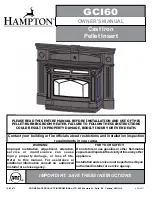
~
10 ~
If the glass does crack when the wood heater is lit, let the fire die out. Do not open the door
until the wood heater has fully cooled. Replace the glass with the specified replacement part
before re-using the wood heater.
Door Adjustments
Horizontal adjustment - When looking at the heater and the door appears to be on an angle
horizontally the door can be adjusted. Lift the door off its hinge, slightly loosen the hinge
bolts and tap hinge either in or out at the top or bottom as required. Re-tighten hinge bolts.
Replace the door and check alignment, repeat earlier steps if further fine adjustment
necessary.
Door closing tension adjustment - As door seals age the seal beds into the heater body, this
will allow air to be drawn in any gaps created. Remove the grub screw from the door handle
shaft on the inside of the door, this will allow the handle to rotate 360°. Rotate the handle 1
full turn anti-clockwise and shut the door. Repeat this step until the door offers a little
resistance to close. Replace the grub screw. Over tightening may cause the door to distort
and break the glass.
Glass frame adjustment - If the glass can move within the door frame the glass frame will
need to be tightened. Lightly pull back the corners of the door seal to reveal a screw head.
Lightly tighten all four corners until the glass no longer moves. Over tightening may place
excessive pressure on the glass and break it.
Replacing parts
Always use genuine replacement parts. Only ever make replacements when the wood heater
is cold. All replacement parts can be ordered from www.scandiastoves.com.au.
Surface finish
Your wood heater should only be cleaned using a damp cloth. Some cleaning products may
leave stains on the wood heater surface. Never use abrasive cloths as these may scratch the
surface. Painted wood heaters can be re-painted by using a good quality, high temperature
wood heater paint. When re-painting, make sure there is plenty of ventilation and follow the
manufacturer
’
s instructions. Allow the paint to fully dry before lighting the stove and allow
extra ventilation for the first couple of fires as some fumes may emit from the stove as the
paint cures.
Trouble Shooting
Fire not burning
A wood heater not burning is generally caused by either a shortage of air and/or incorrect or
damp fuel. If fuel is not the problem check:
That the air controls are opened.
There is no blockage in the flue system.
That the open end of the flue is above the height of any nearby obstructions.
That there is a sufficient air supply into the room and that this supply is not being
taken by an extractor fan.
Glass blackens
Glass usually blackens when:
The fuel is not being burned efficiently because of starvation of air.
Bad quality or damp fuel is being used.
For optimum efficiency always use a good quality dry hardwood.
Smoke in room
If the wood heater is properly installed it should not emit any smoke into your room. Should
this happen, check that your room is not air tight. This can easily be checked by opening a































